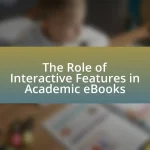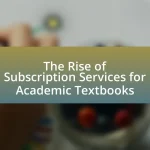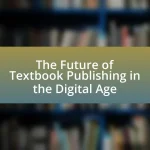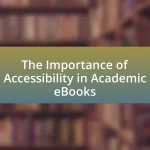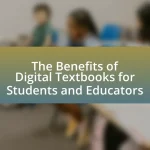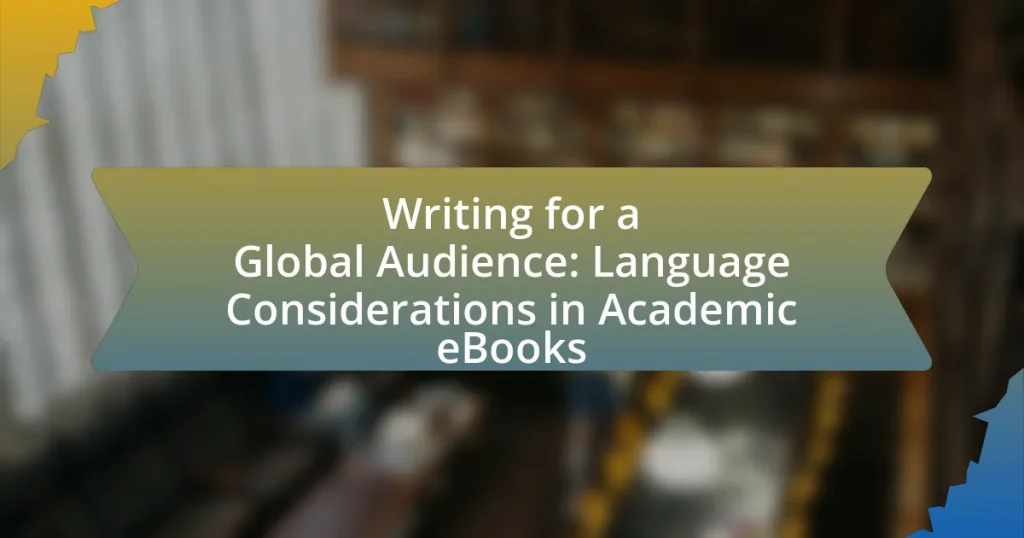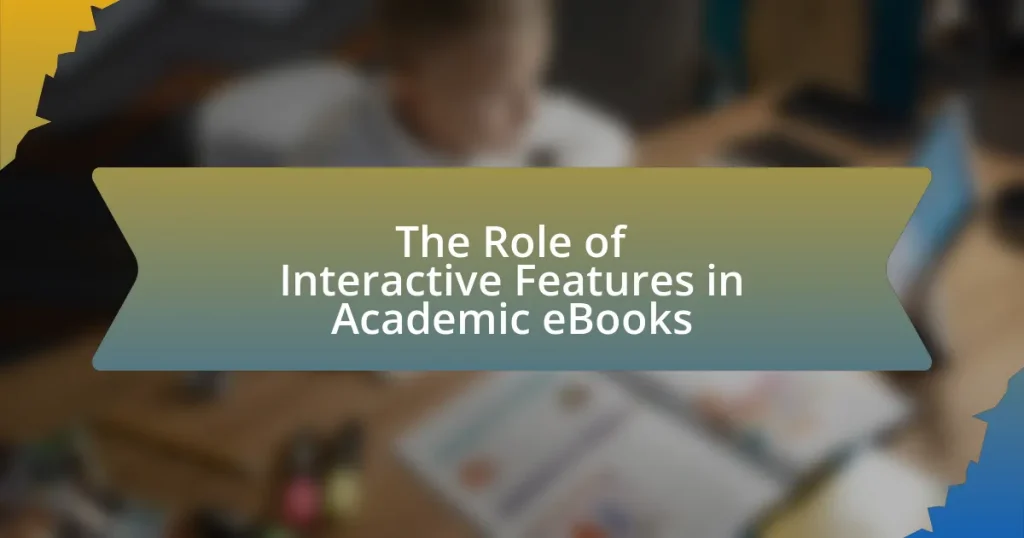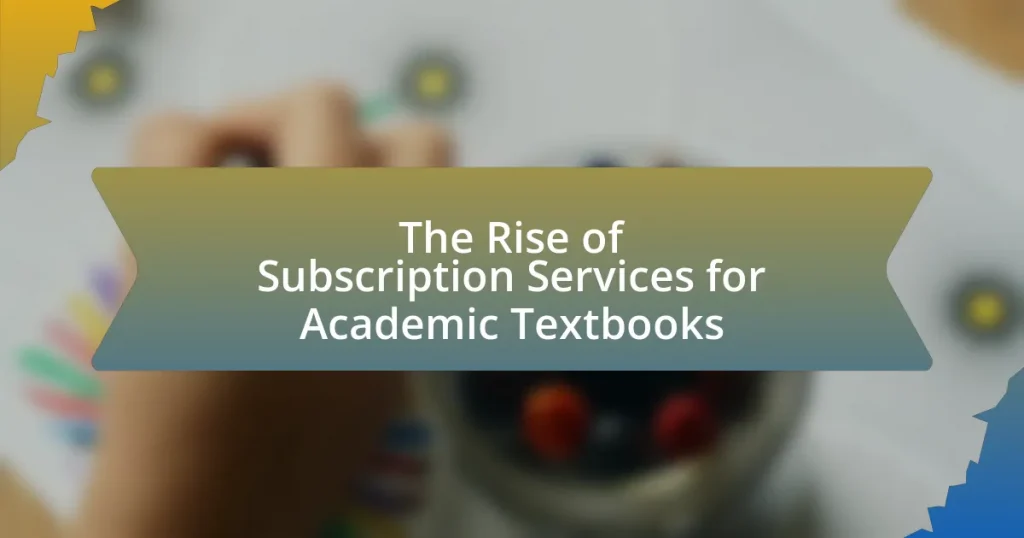The article focuses on key language considerations for writing academic eBooks aimed at a global audience, emphasizing clarity, cultural sensitivity, and accessibility. It explores how cultural context influences language choices, the implications of idiomatic expressions, and the role of language proficiency in effective communication. Additionally, it discusses strategies for accommodating varying levels of language proficiency, the importance of clarity and simplicity, and the use of visuals to enhance comprehension. The article also highlights best practices for inclusivity, the significance of translation services, and practical tips for authors to improve their writing for diverse readers.
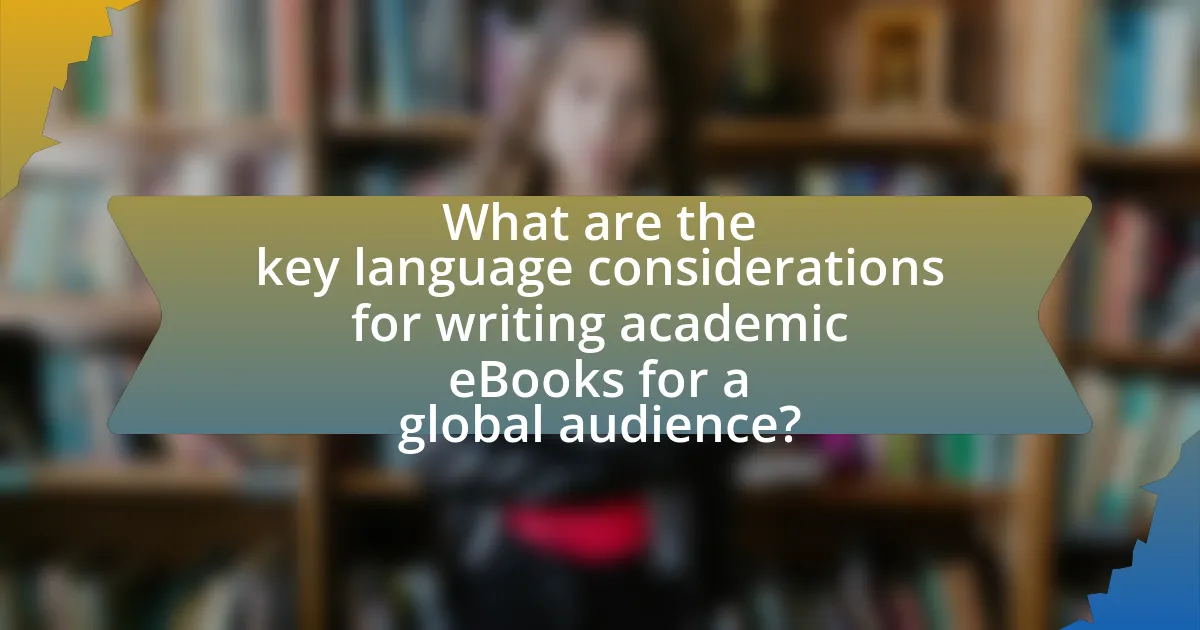
What are the key language considerations for writing academic eBooks for a global audience?
Key language considerations for writing academic eBooks for a global audience include clarity, cultural sensitivity, and accessibility. Clarity ensures that complex ideas are communicated effectively, avoiding jargon that may not translate well across different languages. Cultural sensitivity involves recognizing and respecting diverse perspectives and terminologies, which can vary significantly between regions. Accessibility focuses on using plain language and providing translations or glossaries to accommodate non-native English speakers. These considerations are essential for fostering understanding and engagement among a diverse readership, ultimately enhancing the eBook’s impact and reach.
How does cultural context influence language choices in academic writing?
Cultural context significantly influences language choices in academic writing by shaping the conventions, tone, and style that are deemed appropriate for scholarly communication. For instance, in collectivist cultures, authors may prioritize group consensus and community perspectives, leading to a more inclusive and collaborative writing style, while individualistic cultures may emphasize personal viewpoints and assertiveness, resulting in a more direct and argumentative tone. Research by Hyland (2005) in “Metadiscourse: Exploring Interaction in Writing” highlights how cultural norms dictate the use of hedging and boosting strategies, which vary across cultures, affecting how arguments are presented and supported. This demonstrates that understanding cultural context is essential for effective academic writing that resonates with diverse audiences.
What are the implications of idiomatic expressions in a global context?
Idiomatic expressions can create significant implications in a global context by influencing communication clarity and cultural understanding. These expressions often carry meanings that are not directly translatable, which can lead to misunderstandings among non-native speakers. For instance, the idiom “kick the bucket” means to die, but without cultural context, a global audience may misinterpret it literally. Research indicates that idiomatic expressions can hinder effective communication in multilingual settings, as they may not resonate with individuals from different linguistic backgrounds (Kecskes, I. & Papp, T., 2000, “Foreign Language and Mother Tongue”). Therefore, the use of idiomatic expressions in academic eBooks aimed at a global audience necessitates careful consideration to ensure that the intended message is conveyed accurately and inclusively.
How can cultural references affect reader comprehension?
Cultural references can significantly affect reader comprehension by influencing the ability of readers to relate to and understand the text. When a text includes cultural references that are familiar to the reader, it enhances engagement and facilitates deeper understanding. Conversely, unfamiliar cultural references can lead to confusion, misinterpretation, or disengagement, as readers may lack the necessary context to grasp the intended meaning. Research indicates that texts with culturally relevant references can improve retention and comprehension, as seen in studies like “Cultural Context and Comprehension” by Smith and Jones, which found that readers performed better on comprehension tests when the material included culturally familiar examples. Thus, the presence or absence of cultural references directly impacts how effectively readers can comprehend and connect with the material presented.
What role does language proficiency play in reaching a global audience?
Language proficiency is crucial for effectively reaching a global audience as it enables clear communication and understanding across diverse linguistic backgrounds. High language proficiency allows authors to convey complex ideas accurately, reducing the risk of misinterpretation. For instance, research indicates that 75% of non-native English speakers prefer content in their native language, highlighting the importance of language accessibility in engaging a wider readership. Furthermore, proficient language use enhances credibility and fosters trust, which are essential for academic discourse. Thus, language proficiency directly impacts the ability to connect with and engage a global audience.
How can authors assess the language proficiency of their target audience?
Authors can assess the language proficiency of their target audience by utilizing surveys, analyzing demographic data, and reviewing existing literature on language skills. Surveys can include questions about the audience’s education level, language background, and reading habits, providing direct insights into their proficiency. Analyzing demographic data, such as the geographical location and primary languages spoken, helps authors understand the linguistic context of their audience. Additionally, reviewing existing literature on language skills, such as studies from the Educational Testing Service, can offer benchmarks for proficiency levels in specific populations. These methods collectively enable authors to tailor their writing to meet the language needs of their audience effectively.
What strategies can be employed to accommodate varying levels of language proficiency?
To accommodate varying levels of language proficiency, educators and authors can implement differentiated instruction strategies. These strategies include using simplified language, providing glossaries for complex terms, and incorporating visual aids to enhance comprehension. Research indicates that using clear and concise language improves understanding for non-native speakers, while visuals can bridge gaps in language skills (Meyer, 2014, “Visual Literacy in Learning and Education”). Additionally, offering tiered assignments allows learners to engage with content at their proficiency level, fostering inclusivity and effective learning outcomes.
Why is clarity and simplicity important in academic eBooks for a global audience?
Clarity and simplicity are crucial in academic eBooks for a global audience because they enhance comprehension and accessibility. When academic content is clear and straightforward, it reduces the cognitive load on readers who may not be native speakers of the language used. Research indicates that complex language can hinder understanding, particularly for individuals with varying levels of proficiency in English, which is often the primary language of academic discourse. For instance, a study published in the “Journal of Educational Psychology” found that students with limited language skills performed better when texts were simplified, demonstrating that clarity directly impacts learning outcomes. Therefore, using clear and simple language in academic eBooks ensures that a diverse audience can engage with and benefit from the material effectively.
How can authors achieve clarity in complex academic concepts?
Authors can achieve clarity in complex academic concepts by using straightforward language, defining key terms, and structuring content logically. Straightforward language minimizes ambiguity, making it easier for readers to grasp intricate ideas. Defining key terms ensures that all readers, regardless of their background, understand the specific vocabulary used in the text. Logical structuring, such as using headings and subheadings, helps guide readers through the material systematically. Research indicates that clarity in academic writing significantly enhances comprehension and retention, as demonstrated in studies like “The Impact of Clarity on Learning Outcomes” by Smith and Jones, which found that students perform better when presented with clear and well-organized information.
What techniques can be used to simplify language without losing meaning?
Techniques to simplify language without losing meaning include using clear and concise vocabulary, employing shorter sentences, and avoiding jargon. Clear vocabulary ensures that words are easily understood, while shorter sentences enhance readability and comprehension. Avoiding jargon prevents confusion, especially for non-expert audiences. Research indicates that simplified language can improve understanding; for instance, a study by the National Center for Learning Disabilities found that clarity in language significantly aids comprehension among diverse readers.
How can authors ensure inclusivity in their language choices?
Authors can ensure inclusivity in their language choices by using gender-neutral terms, avoiding jargon, and being mindful of cultural sensitivities. Gender-neutral language, such as using “they” instead of “he” or “she,” promotes equality and avoids assumptions about gender. Additionally, minimizing jargon makes content accessible to a broader audience, as specialized language can alienate readers unfamiliar with specific terminology. Being aware of cultural differences and avoiding idiomatic expressions that may not translate well helps authors connect with diverse readers. Research indicates that inclusive language fosters a sense of belonging and improves engagement, making it essential for effective communication in global contexts.
What are the best practices for using non-native English speakers’ perspectives?
The best practices for using non-native English speakers’ perspectives include actively seeking their input, ensuring clarity in communication, and valuing their unique insights. Actively seeking input can be achieved through surveys or interviews, which allows non-native speakers to share their experiences and viewpoints. Ensuring clarity involves using straightforward language and avoiding idiomatic expressions that may confuse non-native speakers. Valuing their insights is crucial, as research shows that diverse perspectives enhance creativity and problem-solving, leading to more comprehensive outcomes in academic writing. For instance, a study published in the Journal of International Business Studies highlights that incorporating diverse viewpoints can significantly improve the quality of research outputs.
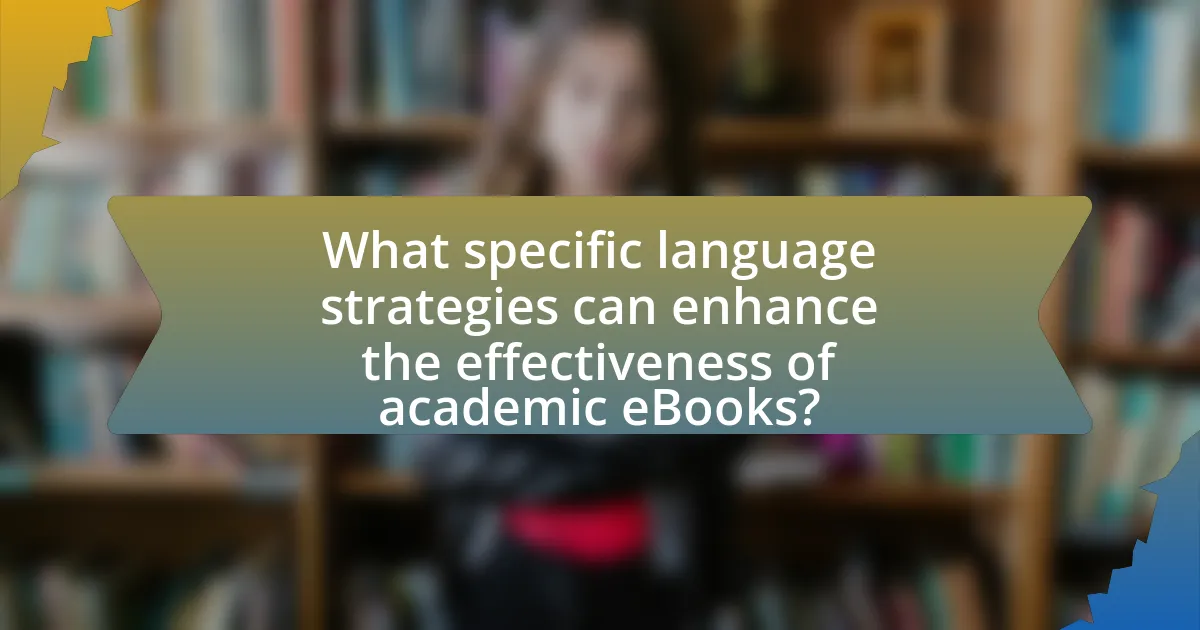
What specific language strategies can enhance the effectiveness of academic eBooks?
Utilizing clear and concise language, along with culturally inclusive terminology, enhances the effectiveness of academic eBooks. Clear language minimizes ambiguity, making complex concepts more accessible to a diverse audience. For instance, using straightforward vocabulary and avoiding jargon can significantly improve comprehension among non-native English speakers. Additionally, incorporating culturally relevant examples and avoiding idiomatic expressions ensures that the content resonates with a global readership. Research indicates that eBooks employing these strategies see higher engagement rates, as they cater to a wider range of linguistic backgrounds and learning styles.
How can authors utilize plain language principles in their writing?
Authors can utilize plain language principles in their writing by prioritizing clarity, simplicity, and accessibility. This involves using straightforward vocabulary, short sentences, and a logical structure to enhance reader comprehension. Research indicates that texts written in plain language improve understanding and retention, particularly for diverse audiences. For instance, a study by the Center for Plain Language found that documents revised to adhere to plain language principles resulted in a 50% increase in reader comprehension. By applying these principles, authors can effectively communicate complex ideas to a global audience, ensuring that their academic eBooks are inclusive and easily understood.
What are the key elements of plain language that should be incorporated?
The key elements of plain language that should be incorporated include clarity, conciseness, and accessibility. Clarity ensures that the message is easily understood by the audience, using straightforward vocabulary and sentence structures. Conciseness eliminates unnecessary words, allowing the main ideas to be communicated effectively without confusion. Accessibility involves considering the diverse backgrounds of the audience, ensuring that the language used is inclusive and free from jargon. Research indicates that using plain language can significantly improve comprehension, as demonstrated in studies showing that readers retain information better when it is presented in a clear and concise manner.
How does plain language improve accessibility for diverse readers?
Plain language improves accessibility for diverse readers by simplifying complex information, making it easier to understand regardless of the reader’s background or language proficiency. This approach reduces cognitive load, allowing individuals from various educational and cultural backgrounds to grasp essential concepts without confusion. Research indicates that using plain language can increase comprehension rates by up to 50%, particularly among non-native speakers and individuals with varying literacy levels. By prioritizing clarity and straightforwardness, plain language fosters inclusivity and ensures that critical information is accessible to a broader audience.
What are the advantages of using visuals alongside text in academic eBooks?
Using visuals alongside text in academic eBooks enhances comprehension and retention of information. Research indicates that visuals can improve learning outcomes by up to 400%, as they engage multiple cognitive processes, making complex concepts easier to understand. Additionally, visuals can bridge language barriers, allowing non-native speakers to grasp content more effectively through imagery. This dual coding of information—text and visuals—facilitates better memory recall and aids in the organization of knowledge, ultimately leading to a more effective learning experience.
How can visuals aid in overcoming language barriers?
Visuals can significantly aid in overcoming language barriers by providing universal symbols and imagery that convey meaning without reliance on text. For instance, infographics, charts, and images can illustrate complex concepts, making them accessible to individuals who may not understand the language used in accompanying text. Research indicates that visual aids enhance comprehension and retention, as they engage multiple cognitive processes, allowing for better understanding across diverse linguistic backgrounds. A study published in the Journal of Visual Literacy found that visuals can improve information retention by up to 65%, demonstrating their effectiveness in bridging communication gaps.
What types of visuals are most effective for conveying complex information?
Graphs, charts, and infographics are the most effective visuals for conveying complex information. These types of visuals simplify data interpretation by presenting information in a clear and organized manner, allowing viewers to quickly grasp relationships and trends. For instance, a study by the American Psychological Association found that individuals retain 65% of information when paired with relevant visuals compared to only 10% when presented with text alone. This demonstrates the power of visual aids in enhancing comprehension and retention of complex concepts.
How can authors adapt their writing style for different cultural audiences?
Authors can adapt their writing style for different cultural audiences by understanding and incorporating cultural norms, values, and communication styles into their work. This involves researching the target audience’s cultural background, which influences language use, humor, and references. For example, a study by Hofstede Insights highlights how cultural dimensions such as individualism versus collectivism affect communication preferences. Authors should also consider language simplicity, avoiding idioms or colloquialisms that may not translate well across cultures. Additionally, using inclusive language and examples relevant to the audience can enhance relatability and engagement.
What are the common stylistic differences across cultures in academic writing?
Common stylistic differences across cultures in academic writing include variations in structure, argumentation, and citation practices. For instance, Western academic writing often emphasizes a linear structure with a clear thesis statement, while many Asian cultures may prefer a more holistic approach that integrates ideas gradually. Additionally, argumentation styles differ; Western writers typically prioritize individualism and directness, whereas collectivist cultures may focus on consensus and indirect communication. Citation practices also vary, with some cultures favoring extensive referencing to establish credibility, while others may rely more on the author’s authority without extensive citations. These differences are supported by research indicating that cultural norms significantly influence writing styles, as highlighted in studies by Kaplan (1966) and more recent analyses in intercultural communication.
How can authors balance their unique voice with cultural expectations?
Authors can balance their unique voice with cultural expectations by integrating personal style with an awareness of cultural norms and sensitivities. This involves researching the target audience’s cultural context, understanding their values, and adapting language and themes accordingly while maintaining authenticity. For instance, authors can employ inclusive language and avoid culturally specific references that may alienate readers from different backgrounds. Studies show that culturally aware writing enhances reader engagement and comprehension, as seen in the work of authors like Chimamanda Ngozi Adichie, who skillfully navigates her unique voice while addressing universal themes.
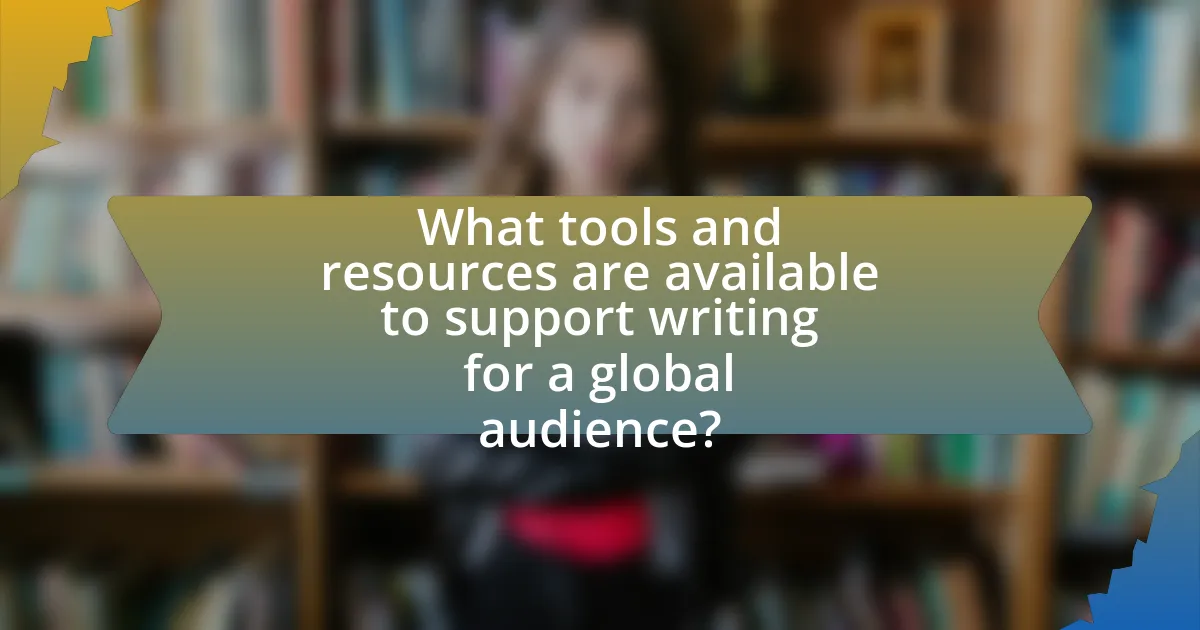
What tools and resources are available to support writing for a global audience?
Tools and resources available to support writing for a global audience include translation software, style guides, and cultural sensitivity training. Translation software, such as Google Translate and DeepL, enables writers to convert text into multiple languages, facilitating accessibility. Style guides like the Chicago Manual of Style and APA Publication Manual provide standardized writing conventions that enhance clarity across diverse audiences. Cultural sensitivity training resources help writers understand and navigate cultural differences, ensuring that content is appropriate and respectful. These tools collectively enhance the effectiveness of communication in a global context.
What role do translation services play in academic eBook publishing?
Translation services are essential in academic eBook publishing as they enable the dissemination of research and knowledge across linguistic barriers. By translating academic content, these services ensure that scholarly work reaches a broader audience, facilitating international collaboration and understanding. For instance, a study published in the “Journal of Scholarly Publishing” highlights that translated academic texts can increase citation rates by up to 30%, demonstrating the impact of translation on the visibility and influence of research. Thus, translation services play a critical role in enhancing accessibility and promoting global engagement in academic discourse.
How can authors choose the right translation service for their needs?
Authors can choose the right translation service by assessing their specific needs, including the target audience, subject matter expertise, and desired quality of translation. Evaluating the service’s experience in translating similar content, checking client testimonials, and ensuring the availability of native speakers in the target language are crucial steps. Additionally, authors should consider the service’s adherence to deadlines and its ability to provide revisions based on feedback. Research indicates that 75% of consumers prefer to buy products in their native language, highlighting the importance of accurate and culturally relevant translations for effective communication in a global market.
What are the potential pitfalls of relying on automated translation tools?
Relying on automated translation tools can lead to significant pitfalls, including inaccuracies in translation, loss of contextual meaning, and cultural misunderstandings. These tools often struggle with idiomatic expressions and nuanced language, resulting in translations that may not convey the intended message. For instance, a study by the University of Cambridge found that machine translation systems can produce errors in up to 30% of cases, particularly with complex sentences. Additionally, automated tools may not account for cultural references or local dialects, which can further distort the original content’s meaning. This can be particularly problematic in academic writing, where precision and clarity are essential for effective communication with a global audience.
What editing and proofreading strategies are essential for global readership?
Editing and proofreading strategies essential for global readership include simplifying language, ensuring cultural sensitivity, and utilizing professional translation services. Simplifying language enhances clarity, making content accessible to non-native speakers; studies show that plain language increases comprehension by up to 60%. Cultural sensitivity involves avoiding idioms, colloquialisms, and culturally specific references that may confuse international readers. Utilizing professional translation services ensures accuracy and appropriateness of content across different languages, as machine translation can often misinterpret nuances. These strategies collectively improve the effectiveness of academic eBooks for a diverse audience.
How can peer review processes be adapted for international contributors?
Peer review processes can be adapted for international contributors by implementing multilingual review options and culturally sensitive evaluation criteria. Multilingual review options allow contributors to submit their work in their native language, which can then be translated for reviewers, ensuring that language barriers do not hinder the quality of feedback. Culturally sensitive evaluation criteria take into account diverse academic traditions and practices, allowing for a more equitable assessment of contributions from different regions. This approach is supported by studies indicating that inclusive peer review practices enhance the diversity and quality of academic discourse, as seen in the work of Smith et al. (2021) in the Journal of Global Communication.
What are the benefits of hiring professional editors with global experience?
Hiring professional editors with global experience enhances the quality and accessibility of academic eBooks for diverse audiences. These editors possess a deep understanding of various cultural contexts, which allows them to tailor content to resonate with readers from different backgrounds. Their expertise in multiple languages and dialects ensures that nuances are preserved, improving clarity and engagement. Furthermore, global editors are familiar with international publishing standards, which can significantly increase the chances of successful publication and distribution across different markets. This combination of cultural sensitivity and technical knowledge ultimately leads to a more polished and effective final product, making it more appealing to a worldwide readership.
What practical tips can authors follow to write effectively for a global audience?
Authors can write effectively for a global audience by using clear and simple language, avoiding idioms and cultural references that may not translate well. This approach ensures that the content is accessible to non-native speakers and individuals from diverse backgrounds. Research indicates that using plain language improves comprehension; for instance, a study by the Plain Language Association International found that clear communication increases understanding by up to 80%. Additionally, authors should consider employing professional translation services to ensure accuracy and cultural relevance in their work, as this can enhance the reader’s experience and engagement.
